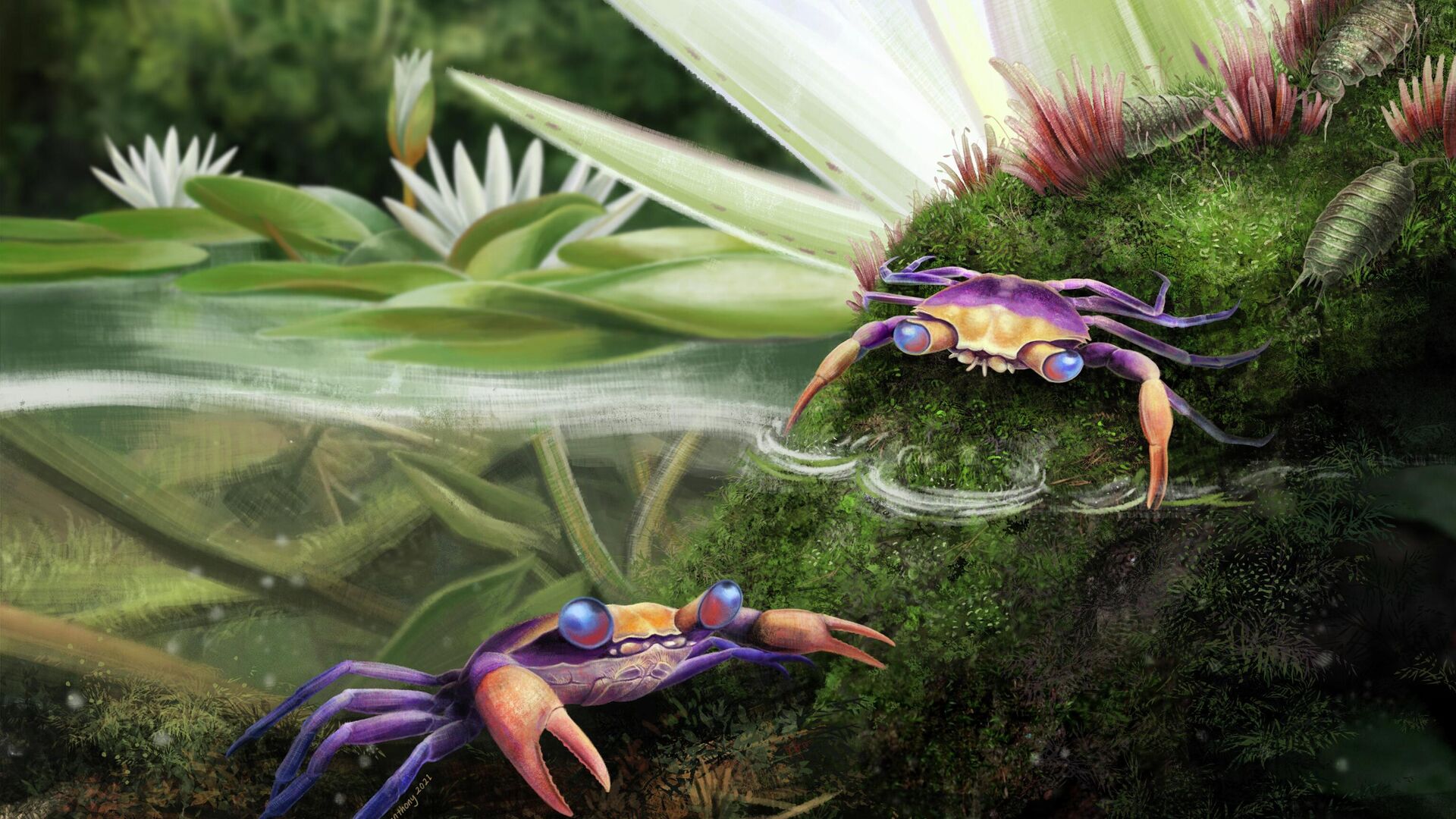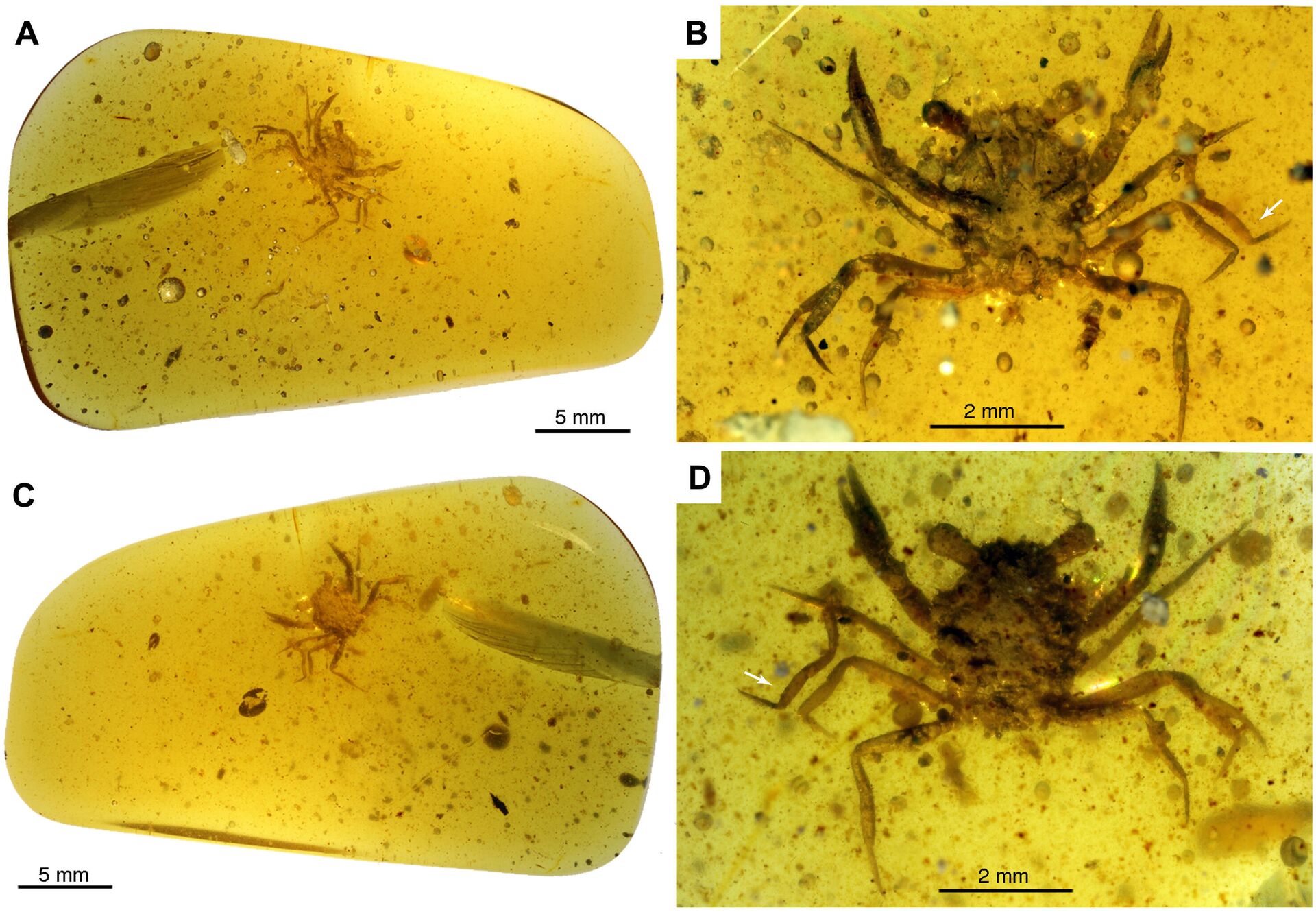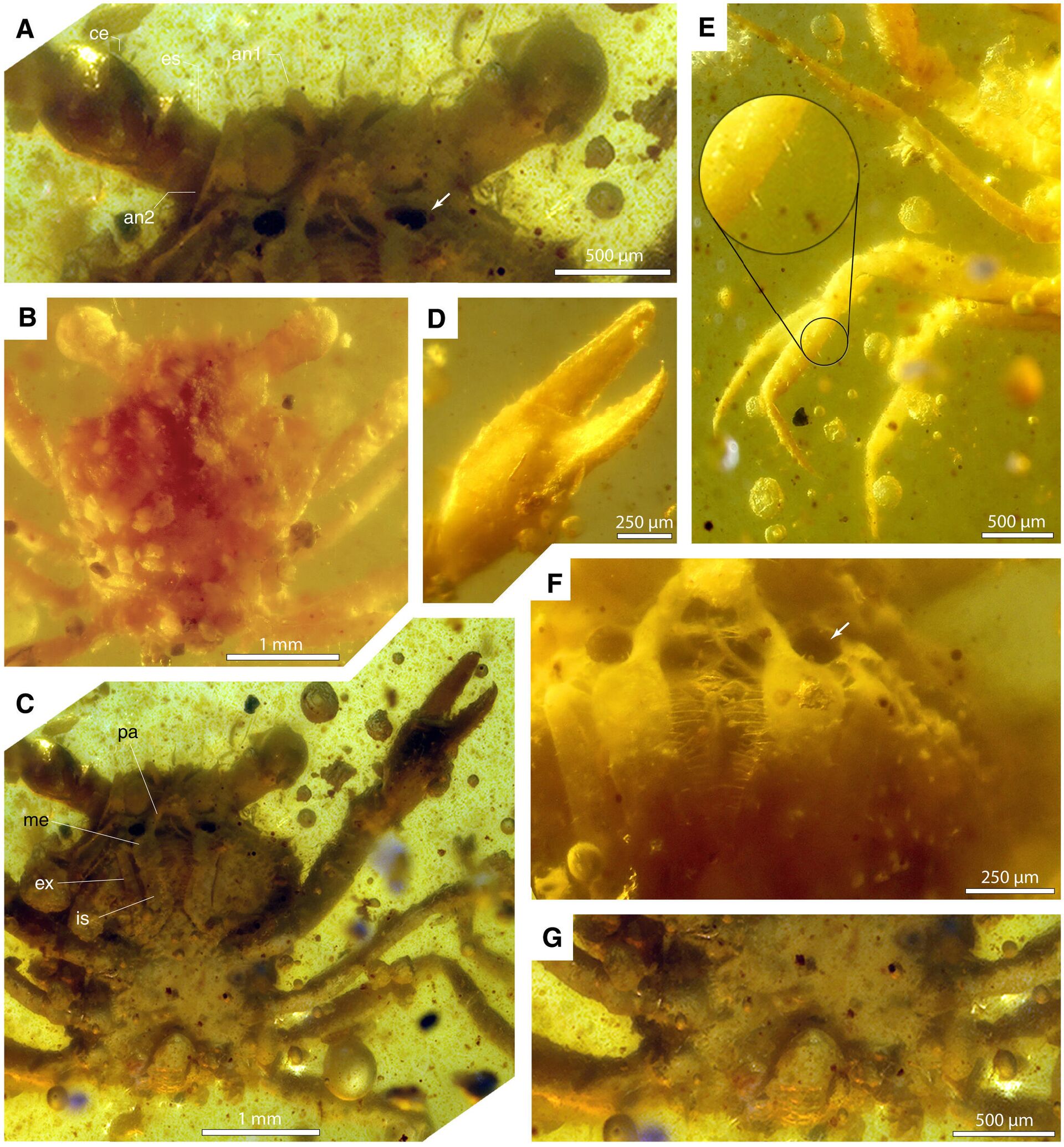https://sputnikglobe.com/20211021/coeval-of-dinosaurs-100-mln-year-old-amber-reveals-one-of-the-oldest-crabs-ever-known-1090088066.html
Coeval of Dinosaurs: 100-Mln-Year-Old Amber Reveals One of the Oldest Crabs Ever Known
Coeval of Dinosaurs: 100-Mln-Year-Old Amber Reveals One of the Oldest Crabs Ever Known
Sputnik International
The 55-millimeter crab was discovered in Southeast Asia's rainforests and is the first dinosaur-era creature of this species yet unearthed. 21.10.2021, Sputnik International
2021-10-21T02:58+0000
2021-10-21T02:58+0000
2021-10-21T02:58+0000
research
crab
science & tech
paleontology
amber
harvard
crab
evolution
research
https://cdn1.img.sputnikglobe.com/img/07e5/0a/15/1090088420_0:0:3072:1728_1920x0_80_0_0_bd1933f0bdc372be0672887f7749c98f.jpg
The first-ever remains of an ancient tiny crab have been unearthed, encased in amber for 100 million years, making it the oldest modern-looking crab ever discovered, an international team of researchers revealed on Wednesday in Science Advances magazine.According to the paper, nonmarine crabs first appeared on land and in freshwater about 75 to 50 million years ago, based on previous fossil records, which mostly consist of bits and pieces of claws.Researchers at Harvard University and the China University of Geosciences, as well as 10 other collaborators who studied the ancient amber, did not believe at first sight that the crustacean trapped inside could assist in filling a critical gap in crab evolution. The research team believes their discovery marks the earliest evidence of "true crab" (in contrast to "false crabs" such as hermit crabs) incursions into non-marine environments.According to the scientists, the Cretaceous Crab Revolution — when crabs expanded globally and began evolving into their distinctive, crabby-looking body shapes — occurred more frequently than previously assumed. This latest study takes the total number of times various crab species have evolved to dwell outside their marine home to at least 12, according to the press release.Cretapsara athanata, or "the immortal Cretaceous spirit of the clouds and waters," was the name given to the new fossil. The name pays homage to its history as well as mythological spirits from South and Southeast Asia. The specimen was discovered by miners in Myanmar in 2015, and it was recently shared with the Longyin Amber Museum in China, which allowed the Harvard team to examine it further. During the study, Luque and his team employed micro-CT scans, which allowed them to see the delicate tissues of the crab's antennae, legs, and mouthparts, which are lined with fine hair, huge compound eyes, and even its gills in detail.The crab could have been a freshwater juvenile species or a semi-terrestrial juvenile crab, according to the researchers. It could have traveled from the sea to land, similar to the famed Christmas Island red crabs, which discharge their offspring into the ocean before returning to shore."The discovery provides new insights into the evolution of these crustaceans and when they spread around the world," Luque concluded.
Sputnik International
feedback@sputniknews.com
+74956456601
MIA „Rosiya Segodnya“
2021
News
en_EN
Sputnik International
feedback@sputniknews.com
+74956456601
MIA „Rosiya Segodnya“
Sputnik International
feedback@sputniknews.com
+74956456601
MIA „Rosiya Segodnya“
research, crab, science & tech, paleontology, amber, harvard, crab, evolution, research
research, crab, science & tech, paleontology, amber, harvard, crab, evolution, research
Coeval of Dinosaurs: 100-Mln-Year-Old Amber Reveals One of the Oldest Crabs Ever Known
Kirill Kurevlev
Managing Editor
The 55-millimeter crab was discovered in Southeast Asia's rainforests and is the first dinosaur-era creature of this species yet unearthed.
The first-ever remains of an ancient tiny crab have been unearthed, encased in amber for 100 million years, making it the oldest modern-looking crab ever discovered, an international team of researchers revealed on Wednesday in
Science Advances magazine.
According to the paper, nonmarine crabs first appeared on land and in freshwater about 75 to 50 million years ago, based on previous fossil records, which mostly consist of bits and pieces of claws.
Researchers at Harvard University and the China University of Geosciences, as well as 10 other collaborators who studied the ancient amber, did not believe at first sight that the crustacean trapped inside could assist in filling a critical gap in crab evolution.
“In a way, it’s like finding a shrimp in amber,” Javier Luque, a post-doctoral researcher in the Harvard Department of Organismic and Evolutionary Biology is quoted as saying in a press release regarding the publication. “Talk about wrong place, wrong time.”
The research team believes their discovery marks the earliest evidence of "true crab" (in contrast to "false crabs" such as hermit crabs) incursions into non-marine environments.
“If we were to reconstruct the crab tree of life — putting together a genealogical family tree — and do some molecular DNA analysis, the prediction is that nonmarine crabs split from their marine ancestors more than 125 million years ago,” Luque said. “But there’s a problem because the actual fossil record— the one that we can touch - is way young at 75 to 50 million years old… So this new fossil and its mid-Cretaceous age allows us to bridge the gap between the predicted molecular divergence and the actual fossil record of crabs.”
According to the scientists, the Cretaceous Crab Revolution — when crabs expanded globally and began evolving into their distinctive, crabby-looking body shapes — occurred more frequently than previously assumed.
This latest study takes the total number of times various crab species have evolved to dwell outside their marine home to at least 12, according to the press release.
Cretapsara athanata, or "the immortal Cretaceous spirit of the clouds and waters," was the name given to the new fossil. The name pays homage to its history as well as mythological spirits from South and Southeast Asia.
The specimen was discovered by miners in Myanmar in 2015, and it was recently shared with the Longyin Amber Museum in China, which allowed the Harvard team to examine it further. During the study, Luque and his team employed micro-CT scans, which allowed them to see the delicate tissues of the crab's antennae, legs, and mouthparts, which are lined with fine hair, huge compound eyes, and even its gills in detail.
The crab could have been a freshwater juvenile species or a semi-terrestrial juvenile crab, according to the researchers. It could have traveled from the sea to land, similar to the famed Christmas Island red crabs, which discharge their offspring into the ocean before returning to shore.
"The discovery provides new insights into the evolution of these crustaceans and when they spread around the world," Luque concluded.





